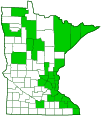American Copper
(Lycaena phlaeas)
Conservation • Description • Habitat • Ecology • Distribution • Taxonomy
Conservation Status |
|
|||||||
| IUCN Red List | not listed |
|||||||
| NatureServe | N5 - Secure SNA - Not applicable |
|||||||
| Minnesota | not listed |
|||||||
Description |
||
American Copper is a small to medium-sized butterfly with a wingspan of ⅞″ to 1⅛″. The upper surface of the forewing is bright coppery reddish-orange with black spots and a broad, dark brownish-gray submarginal band. There are 9 distinct black spots: a cell spot, a cell end spot, and 7 postdiscal spots. The cell end spot is 1 ⁄32″ to 3 ⁄64″ wide. The lowermost pair of postdiscal spots is frequently fused together. The submarginal band is 15½% of the total wing width when measured near the middle (vein Cu1). The hindwing upper surface is dark brownish-gray with pale spots, black spots, and a wide, distinct, brownish-orange submarginal band. The submarginal band has 5 black spots the two lowest (closest to the anal angle) fused together. The underside of the forewing is orange with a pale brownish-gray submarginal band. The black spots on the upperside are reflected on the lower and are bordered with white. There is also an additional basal spot and row of 3 or 4 submarginal unbordered spots. The underside of the hindwiing is light brownish-gray with a broad, slightly darker submarginal band. Within the submarginal band there is a narrow, strongly wavy/serrated, bright orange band. The antennae are black-and-white striped with a orange-tipped club. The caterpillar is short, no more than about ⅝″ long. The head is small. It is retracted into the thorax except when feeding. The thorax and abdomen are green. They are densely covered with short hairs and are dappled with tiny, white, mushroom-like glands that may not be apparent without a hand lens. The middle of the first thoracic segment is cleft. The abdomen has a thin upper (dorsal) stripe. Mature caterpillars are found from early June onward. -------------------------------- The description above refers to the eastern subspecies, Lycaena phlaeas hypophlaeas. |
||
Size |
||
Wingspan: ⅞″ to 1⅛″ |
||
Similar Species |
||
| Bronze copper (Lycaena hyllus) is much larger with a wingspan of up to 1½″. Males are purplish above with no orange on the forewing. The female forewing is paler yellowish-orange. The hindwing underside is paler, almost white, with a broad orange submarginal band. | ||
Habitat |
||
Disturbed areas: vacant lots, fields, pastures, roadsides, power lines, and lake shores. |
||
Ecology |
||
Season |
||
Two broods: June to early July and August to September |
||
Behavior |
||
Caterpillars hide in lower leaf stalks or decaying plant litter or at the base of a host plant during the day. They emerge at night to feed on leaves. They are attended by ants in a symbiotic relationship. Tiny, mushroom-like glands on their body occasionally exude a chemical that attracts ants. Adults often bask on bare ground. Males are territorial and will challenge any small insect or other copper that enters their territory. |
||
Life Cycle |
||
The female lays pale green eggs singly on the upper side of leaves or stems of host plants. When the eggs hatch the larvae feed on the underside of leaves. Younger larvae chew holes in the lower surface, older larvae create longitudinal channels. Both leave the upper epidermis intact. After about three weeks they drop off the plant. They pupate in leaf litter or under rocks. They overwinter as second or third instar caterpillars and pupate in late March of the following year. The first brood adults emerge three weeks later. |
||
Larva Hosts |
||
Curly dock (Rumex crispus), pale dock (Rumex altissimus), and red sorrel (Rumex acetosella) |
||
Adult Food |
||
Flower nectar |
||
Distribution |
||||
|
Sources |
|||
| 7/20/2022 | ||||
Occurrence |
||||
Widespread and locally common |
||||
Taxonomy |
|||
Order |
Lepidoptera (Butterflies and Moths) | ||
Superfamily |
Papilionoidea (Butterflies) | ||
Family |
Lycaenidae (Gossamer-winged Butterflies) | ||
Subfamily |
Lycaeninae (coppers) | ||
Genus |
Lycaena (copper butterflies) | ||
| Subgenus | Lycaena | ||
Subordinate Taxa |
|||
American Copper (Lycaena phlaeas alpestris) Beartooth copper (Lycaena phlaeas arctodon) Arethusa copper (Lycaena phlaeas arethusa) Yellowish American Copper (Lycaena phlaeas feildeni) Little copper (Lycaena phlaeas hypophlaeas) |
|||
There are at least 27 subspecies of Lycaena phlaeas worldwide. Only 5 occur in North America. Only one subspecies is found in eastern and central North America. For many years it was called Lycaena phlaeas americana (Harris, 1862). This was later determined to be a junior synonym of an older name Lycaena phlaeas hypophlaeas (Boisduval, 1852). This is the only subspecies found in Minnesota. Some authorities (Opler & Krizek [1984] and Opler & Malikul [1992]) suggest that the eastern subspecies was introduced from Europe. This is based on appearance; the preferred larval food plants, which were introduced from Europe; and the preference for disturbed places. This contention is rejected by other authorities based on difference in appearance and the ability of native species to adapt to introduced food plants. Mitochondrial DNA analysis would settle the issue but has not yet been performed. |
|||
Synonyms |
|||
|
|||
Common Names |
|||
American Copper (North America) common copper little copper small copper (Europe) |
|||
In North America we call this species American Copper but there is nothing distinctively American about it. Elsewhere it has many names depending on the region it is found. In Europe it is called small copper, which may be the most appropriate global name. |
|||
Glossary
Anal angle
In insects: The angle at the corner of a wing formed where the outer and inner margins meet.
Cell
In Lepidoptera: the large central area of the wing surrounded by veins.
Instar
The developmental stage of arthropods between each molt; in insects, the developmental stage of the larvae or nymph.
Visitor Photos |
|||||
Share your photo of this insect. |
|||||
| This button not working for you? Simply email us at info@MinnesotaSeasons.com. Attach one or more photos and, if you like, a caption. |
|||||
Mike Poeppe |
|||||
 |
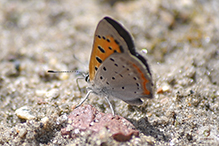 |
||||
Nancy Falkum |
|||||
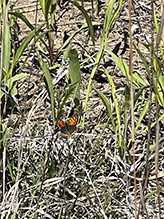 |
|||||
New Jersey Tea with American Copper Butterfly (Lower Right) |
|||||
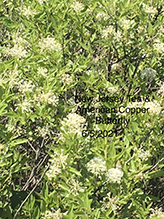 |
|||||
MinnesotaSeasons.com Photos |
|||||
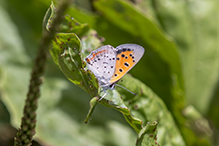 |
|||||

Slideshows |
||
| American Copper DianesDigitals |
||

|
||
About
Copyright DianesDigitals |
||
| Lycaena phlaeas (American Copper) Allen Chartier |
||
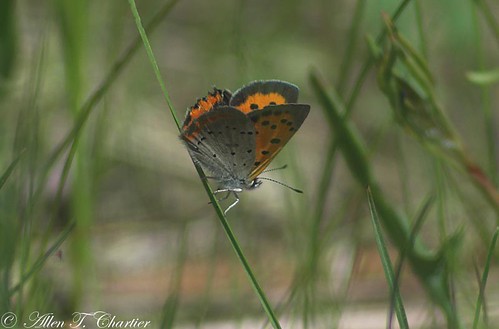
|
||

Visitor Videos |
|||
Share your video of this insect. |
|||
| This button not working for you? Simply email us at info@MinnesotaSeasons.com. Attach a video, a YouTube link, or a cloud storage link. |
|||
Other Videos |
|||
| American Copper - November 6, 2013 Don Gagnon |
|||
About
Published on Nov 6, 2013 American Copper (Lycaena phlaeas), Nectaring Sheffield Pink Chrysanthemum, Butterfly Garden, Gagnon Wildlife Habitat, Pottersville, Somerset, Massachusetts, Wednesday afternoon, November 6, 2013, 1:08 PM / 1:13 PM / 1:14 PM - Canon PowerShot SX50 HS MvI_56011 / MvI_56048 / MvI_56049; 1:26 min. |
|||
| American Copper Nectaring Butterflyweed - August 25, 2013 Don Gagnon |
|||
About
Published on Aug 27, 2013 American Copper (Lycaena phlaeas) nectaring Butterflyweed (Asclepias tuberosa), Butterfly Garden, Gagnon Wildlife Habitat, Pottersville, Somerset, Massachusetts, Sunday afternoon, August 25, 2013, 11:14 AM / 11:15 AM / 11:17 AM / 11:22 AM - Canon PowerShot SX50 HS MvI_43118 / MvI_43119 / MvI_43120; 2:48 min. SHOW MORE |
|||
| American Copper Butterfly (Lycaena phlaeus) Kim Smith |
|||
About
Uploaded on Jul 11, 2010 The brilliantly colored "Flame Copper" nectaring at shasta daisy 'Becky' (Leucanthemum x superbum), filmed in our Gloucester garden. More information abut butterfly gardening on my word press blog at kimsmithdesigns. |
|||
| American Copper Butterflies ffrleps |
|||
About
Uploaded on May 31, 2007 Mating American Copper butterflies, at Indiana Dunes National Lakeshore, May 13, 2007 |
|||


Created 3/18/2019
Last Updated:
